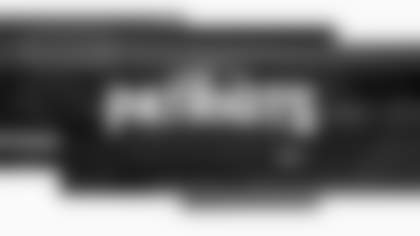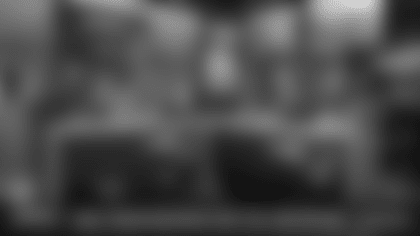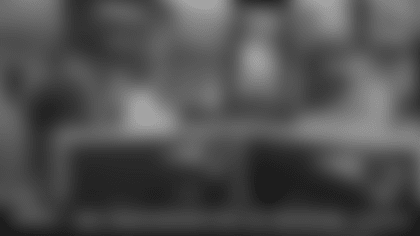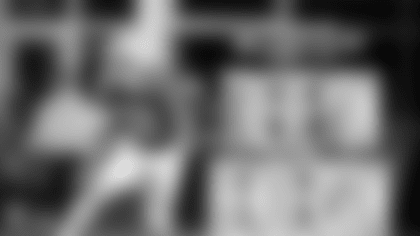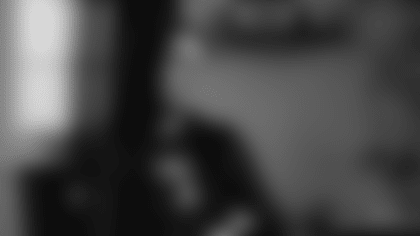[

]()
Q: Is the field in Champaign, Ill. marked differently?
BB: Yeah. (It has) college markings.
Q: Have you talked to the players about that?
BB: You bet. Every day. We talk to them about it every day.
Q: What is the difference?
BB: The numbers that are on there are for a college field and they are about four yards wider than where the pro numbers are. What they have for the pro numbers are a little hash mark type that are about maybe, I don't know, a yard long and they run perpendicular to the yard line, you know, each yard line. They are, of course, two yards wide and that simulates the numbers box where the NFL would be. But the actual numbers themselves are four yards wider. Then, of course, you have the hash marks, which are wider. They are a third of the field in college football. Whereas in the NFL they are six inches apart and roughly 24 yards from the sideline give or take nine inches there. So there are two sets of hash marks. There is one set of numbers and the numbers are wider. The actual pro numbers are just little small lines on the field.
Q: Could it throw off the way you line up?
BB: Well, yeah. It definitely affects your alignment. There are a lot of … I am sure every team in the league on patterns and for alignments where a receiver lines up on the inside of the numbers on the outside edge of the numbers, two yards outside the numbers, a yard inside the numbers all those kind of things that when you run routes, a lot of times wherever you line up, regardless of where you line up, you stem to a yard inside the number or you stem to wherever you want the route to go. Coverage lane is the same thing. Kickoff coverage, punt coverage, you have to adjust to the ball naturally but in terms of your initial landmark, you know, I'm going to release and I'm going to release between the hash marks and the numbers or I'm going to release to the inside edge of the numbers or I'm going to release two yards outside the hash marks or whatever it is. It's the same thing with defensive backs, when a receiver gets to a certain width, you would move him outside technique back to inside technique. And, again, easy landmark for everybody, whether it's the numbers or two yards outside the numbers or one yard outside the numbers, whatever your cut-off point is team-by-team. But to identify that marking on this field is a little bit different. And that is why all the pro fields are marked the same so that competitively, it's the same for everybody.
Q: The pro hash marks are still on both sides of the field right?
BB: Right. Both have the hash marks. If you're just looking at the field, it's no problem you know where the pro hash marks are. But again, on punt coverage, you're blocking a guy and you get spun around at the line of scrimmage and now you get up, you know your landmark is two yards outside the numbers and you see that hash mark at least you kind of know where to get going and then figure it out from there. But now with two sets of hash marks, its just, not saying it changes the game or anything, but for each guy and how it affects him, its just one little more thing that you have to be aware of.
Q: Did you put two out on the practice field?
BB: No, we didn't because the field is already … I think it would just be more confusion to be honest with you. But it is something that we talked about. The Bears have played half their games there so there is plenty of tape on it and you can see it there. It's obvious when you look at it. But then when you look at receivers, I mean, at times you see receivers lined up two yards outside the college numbers which is wider than they would almost every line up on a pro field. It's clear they have gotten confused and they're lining up on the numbers but it's the wrong numbers. And trying to run, sometimes the patterns they try to run which you know are based on running them relative to the numbers, but know its four yards wider than that and of course then it looks like a bad pattern.
Q: Does (University of) Illinois play at home tomorrow?
BB: I don't know.
Q: With your receivers, is it unusual in today's game to have three receivers that are so productive that are so small in size?
BB: Might be. I think probably, just in terms of size, there probably aren't three other smaller receivers in the league. Some teams have one, or maybe have two. But I think our three, in terms of production and in terms of size, there probably isn't another group that goes with that at least not that I know right off hand.
Q: Is there production? Is size that big of a factor? Obviously size has its advantages?
BB: Right. Size has its advantages and I would say there are more bigger receivers than there are smaller ones. There are some receivers that are undersized that are productive just like there are running backs who are undersized, just like there's some defensive linemen. (If) the player is undersized then he has got something else that he's gained an advantage with, usually quickness or technique. Sometimes speed.
Q: Did you expect that (Deion) Branch would have the type of impact that he has had?
BB: Well, I thought that coming in he would be able to do a good job for us once he learned the system and could figure out what was going on and you don't know whether that is going to be two preseason games, half a season, or two years. You just don't really know. All the things that Deion has done this year, he did in college. He's returned kicks. He shows his speed and his elusiveness in kick returns at Louisville. He was productive on long balls, productive on short intermediate balls as well, productive after the catch, you know, didn't drop a lot of balls. Every receiver drops balls, but I mean he's got good hands, let's put it that way. He has been competitive in most of the things we have asked him to do. I think if you go back to Louisville tape you will see that. It's not like a guy that … I mean he had two years of, I think, well over 1,000 yards, so it wasn't like he didn't have production in college. He did.
Q: But he was like the 10th receiver taken in the draft. Did people just overlook him because of his size?
BB: You would have to ask those teams. I'm not really sure. Because it wasn't his production. I mean, he's got production and they played at a good level of competition.
Q: You mentioned earlier this week in regards to the offensive philosophy, you can't change the offense like you change underwear. Defensively, it almost seems like you would do that with the foundation for your defense. But like you said you only have a couple of days to improve so you can't change the defense. What's the basis of it?
BB: Well it's all part of the system. Those are things that we've worked since the beginning of training camp and back to mini camp.
Q: But do you have something like a foundation defense where you are just able to do different things? What's the core philosophy of defense?
BB: Let's just take Pittsburgh for example. Pittsburgh is a three-four team. They put three, four people out on the field but most of time they are not in a three-four defense. They are in some type of either over-shifted or even front, which really plays like a four-three. When you're on offense and you see where the players are you have to block them like a four-three. Because it's not a three-four, it's a three-four split one way or the other which is just like being in a four-three over under. The thing is you don't know which way it's going to slide whereas if you have a four-three team, you can see where the over is and where the under is based on where the defensive linemen set up. In a three-four defense, the way they play, they shade it one way or the other. It's over one play and it's under the next but the same guys are out on the field so you have to identify it. I'm just saying I think that is fairly common within most defensive systems that you can … the difference between a three-four and a four-three is the substitution of personnel. It's taking a defensive lineman out and putting a linebacker in. When you get into a player like Willie McGinest, what is he? Do you want to call him a linebacker? Do you want to call him a defensive end? And you could probably call him either one based on what his responsibility is on that play. Just like Joey Porter. You can call Joey Porter a linebacker if you want to. He rushes half the time. So when he is rushing you better block him like a defensive end. The same thing with (Jason) Gildon. But again, you don't know which one it's going to be a lot of times until they come out and line up and show you where the front is, that once it's declared Gildon is really an end in terms of his responsibility. He's a versatile enough player where he really plays like an end and of course they play him as an end on sub. In answer to your question, you have a defensive system, and from a week-by-week basis you draw from that system. Now whether Pittsburgh plays over cover two or under cover two or even cover two, it's probably cover two for everybody else, it's just a question of how you set the front to try to change up the look on the offense and do the same thing for us. If we played 34 cover two or four three over cover two, or some other version of cover two, big nickel cover two, that's cover two for everybody but the front changes or maybe a personnel switch is made to change up the look.
Q: How about your style? I think that people would say that you are not attacking defenses. You know, that the gap-controlled defense is not always assigned to attacking the offense. Now that is perception anyway. Is that fair?
BB: Situationally it is. Absolutely. Again, there is so much a defense is based on in situations so if we want to attack and get up the field we can do that. It's not something that we do a lot of in running situations. So, in that respect, no. The more the situation changes from not being a running situation then the less reason there is for you defensively to stand there on the line and run techniques or gap controls as you referred to it, whether it's do that. The time you want to attack is when you are attacking into either a passing situation or if you want to play that kind of defensive style in run situations, as I've talked about before, it just comes down to simple math, for you to control all the gaps, you need somebody in the secondary to come down and control the gap in order to be able to hit every gap.
Q: You look at the last game (Buffalo) and say maybe the Atlanta game last year; you looked different in the way you played up front, a lot more attacking into the pocket…
BB: In the Buffalo game?
Q: Yeah.
BB: Attack it into the pocket? From a pass rush situation?
Q: Far more blitzing …
BB: Let's see. We really didn't blitz that much against Buffalo. But again, let me say this. Anytime you have multiple linebackers and defensive backs on the field, if you have four down linemen and you blitz anybody else, it's really a blitz. Because once you start bringing more than four guys defensively it becomes a blitz and offensively it becomes a blitz in terms of protection. The fifth guy in terms of numbers creates a blitz. So if you have three down linemen and you bring somebody else, you're in a blitzing mode. If you don't have four down linemen in the game, say you only have three, and you bring that fourth rusher. That fourth rusher is really a down lineman for the defense. But it may or may not be a down lineman for the offense depending on how they have treated that guy. So if they treated him as a linebacker, then it really appears as a blitz to them. And one of the linemen who they counted as a lineman drops, and he really becomes a linebacker kind of on the run if you will. To try to simplify it for you, defensively, if you have a situations like Pittsburgh has or like we would have, where Joey Porter and Jason Gildon are your ends in the sub and they drop off and cover and two other guys come, that's really a blitz to the offense. It's a blitz to all of us. But to Pittsburgh, it's not really a blitz, they've still got seven guys in coverage, they've still got two guys in cover zone in Gildon and Porter but now they brought two safeties or a safety and a linebacker which create the blitz appearance to the offense, yet it allows them to play their regular coverage. And we have some of that same flexibility whether it be with McGinest, (Mike) Vrabel, (Tedy) Bruschi. Again, if you have bigger linebackers like that, McGinest is an example, you have some flexibility with that. If you are playing with a 220 pound linebackers who run 4.5 you don't really have that kind of flexibility because they can't play like down linemen and rush. They play more like defensive backs. They give you flexibility with your safeties where you can extend them into coverage further than you could with say a Joey Porter to take a name.
Q: The perception is that after last week …
BB: And I'm just saying we didn't blitz as much. Again, you can get out there by not blitzing if you interchange and drop your rushers and blitz your cover guys so-to-speak. So, there's definitely that element because you saw the number of defensive backs and linebackers we had on the field.
Q: Last year you spent a lot of time with the offense and the quarterbacks. Are you still doing that?
BB: It's almost the same as it was last year, yes.
Q: What areas do you concentrate on with Tom (Brady) in practice?
BB: (I) try not to screw him up.
Q: Isn't that the same thing you did last year?
BB: Charlie (Weis) and I kind of have a little bit of the same … it's basically the same arrangement that we had last year where Charlie spends time with the quarterbacks and then there are other times when he, as a coordinator, works with the entire offensive team. Rather than the quarterbacks to double and hear all that information again then I take them and go on to a different area. I cover certain areas that he doesn't cover. And Charlie, because of his responsibilities that he has in terms of the overall coordination of the offense and play calling and setting up the game plan and so forth, some of the things that normally a quarterback coach would do with the quarterbacks his time is really more viable and extended into the overall offensive coordination and development.
Q: If the situation presented itself, would you bring in a quarterback coach?
BB: I don't know. It would depend on who the person was, what the situation was and so forth. Again, some of this is a carry over from last year. And what happened last year at the point and time that we had to make the change was unplanned and we felt like we had control of the situation and the best thing for us to do would be to teach what we know, rather than to try to bring in somebody else and teach them our system and let them teach it. At the end of the year, the decision was made really to continue that same format. Now whether at some point in time that would change or could change, I mean it could, I don't know. It's not planned to change, but that doesn't mean that it couldn't.
Q: Would you be hesitant to bring in a new guy because of the continuity you have as a staff, even if it was somebody that you knew already?
BB: No. I wouldn't have any hesitation bringing in a new guy. There are a lot of coaches on this staff that I hadn't coached with until I came here. So I don't have a problem with that at all. It's just finding the right fit and that's not to say that there aren't good coaches on every team. There are plenty of them. There is a certain … your staff has a certain way of functioning. There's a certain protocol and a system that is in place and when you change that, you might be able to improve one thing, but then that may affect something else, you just have to try to decide how overall it would fit together.
Q: As far as Greg Robinson-Randall, what has he shown you since the beginning of the year?
BB: I thought going into last week that Greg was the best prepared to play the position in the game. Greg has shown a lot of diligence all year and those opportunities have been limited, he knows it, I know it, we all know it. You only try to play one person at a position on the offensive line and as the season has gone along, I think that he has been able to show some improvement and there was a point in time where we just felt like he was the best one prepared to play that spot. That doesn't mean it's permanent. I mean, it isn't permanent but that was the decision that we made. And that was also made with him splitting a little bit of time in a couple of previous games which is something that we really wanted to do, but we never felt like, competitively, it was warranted. If a guy shows that he is performing well enough to deserve more playing time, then I think you have to give it to him.
Q: Can you assess Jerry Azumah? Has he become a legit corner? For a couple of years it was just running back playing corner …
BB: Yes. He's no running back playing corner.
Q: Can you assess what he brings to their defense?
BB: First of all I think that the Bears have a very unusual situation in that their two starting corners are really former highly productive offensive players with (R.W.) McQuarters and Azumah. Nobody has run the ball better than Azumah has and look at all the competition he played in college and watching him play and studying him this year, he is definitely a corner. He had good skills to play corner. He runs well, he's aggressive, he tackles well. He's got enough quickness and when McQuarters was hurt, he was on everybody's best receiver. Whoever they played, he covered them. It wasn't like he was in any nickel situation or anything like that. He was out there and he was out there for every play. I think that he shows good athleticism. He's tough he's got quickness and he's got some good body strength. He doesn't play small out there, he certainly can hold his own in terms of his playing strength. It's really impressive and there aren't many guys that I've seen do that particularly at that position. He's been an impressive guy to watch on tape.
Q: In all your years in the NFL, is that something that you have seen before? Does he remind you anybody going from, I mean, not just playing offense but being …
BB: (He's) really productive on offense.
Q: At one point in college he had more rushing yardage than anyone. When you think back is he reminiscent of anyone?
BB: I think you would have to go back a ways. Most of the college conversions come more like McQuarters conversion came, (it) was in college where he went from receiver to defensive back in college and then ends up being an NFL defensive back. As opposed to making that move after college or even once he got into the NFL, I'm not sure if when the Bears signed him whether signed him as a back or a defensive back or …
Q: Well they said, like the day after they signed him, that he was going to play defense. They thought safety/corner although they though corner.
BB: Okay. I'm saying, essentially they made the move after they signed him. Whether it was the day after, the week after or mini-camp.
Q: They said to him when he got there 'your back days are over'
BB: Again, usually that happens at the high school level or the college level and that's how the defensive players, and I tell them this a lot, a lot of you guys should send a part of your check to whoever moved you to defense because if they had left you on offense you wouldn't be playing pro football. A lot of times they don't want to hear that but it is in their best interest at whatever point that happens.
Q: I think he is a little bit different there. I mean you could make an argument that maybe he could have played offense.
BB: It's hard to say that he couldn't based on his college production, which is as you said, it's rare. It's exceptional what he did in college. Walter Payton couldn't do that. You're putting him in a high level of production there.
Q: What did Tebucky (Jones) say when you told him that?
BB: Syracuse made that move. It was his senior year he went from running back to safety. I tell him the same thing. Whether it was your defensive coordinator or your running back coach, whether it was the head coach, whoever it was, he's done a whole lot better on defense than I think he would be doing at running back. So I think he should contribute to that charity. And most of those defensive backs that don't catch the ball real well, there is a good reason why some coaches move them from offense to defense because they got tired of watching them drop the ball as receivers. And if you just watch our defensive backs go through their ball drills, you'll see why none of them played offense for very little. I know Ty (Law) wants to be a receiver and all of that but most of those guys they don't catch well enough to play receiver that's why they are defensive backs. And the same thing with the linebackers. They couldn't run fast enough to be running backs or couldn't see the hole well enough to find where to run, they are a lot better off on the defensive side of the ball too where they can find the runner instead of trying to find the whole where there is a lot more variables.
Q: Could you see him at center?
BB: Not a very good one.






